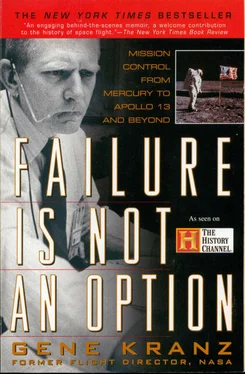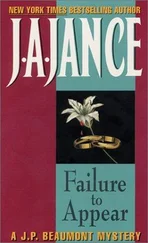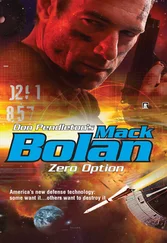At capsule acquisition, the Hawaii CapCom advised Glenn, “Friendship 7, we have been reading an indication on the ground of Segment 51, which is heat shield deploy. We suspect this is an erroneous signal and would like to check it out. Place the landing bag switch in auto and see if you get a light.”
Glenn responded, “Negative. In automatic position did not get a light and I’m back in the off position now, over.”
Kraft turned again to Williams. “Walt, this is the best damned data we can get. The test was negative. We should go ahead with the normal reentry sequence.”
Without waiting for a response, Kraft advised Hawaii, “Tell Glenn we will go ahead with the normal reentry sequence.”
Kraft’s instruction to the Hawaii CapCom surprised Williams. Still not satisfied that the test was valid, Walt continued to question the engineers over the telephone. He was getting a mixed input—the design engineers had conflicting feelings. Stormily closing off the final conference call, he said, “If reentry with the retropack is safe, what do we lose by coming in with the pack on?”
While the debate continued, Glenn had now made contact with the California site, and Huss started the countdown to retro sequence. The count was relayed to the capsule at California by Wally Schirra: “Five… four… three… two… one… MARK.”
Glenn responded, “Retro sequence green.”
Thirty seconds later the retros fired and John Glenn was heading back to Earth. All that was needed was the final decision on whether to retain the retropackage to keep the heat shield in place during the reentry. Schirra said, “Attitude looked good, John. Keep your retros on until you pass Texas.”
Glenn asked several times during the pass about the retropack jettison time. Schirra advised him, “You’ll get the final word over Texas.”
Kraft called Schirra: “California, can you confirm that all three retros fired?” Wally: “Affirmative, Chris.”
In his role as the operations director, Williams leaned toward Kraft, and quietly but firmly said, “That settles it, we’re coming in with the pack on.” Kraft nodded. Williams was the boss and the final decision was made.
Chris got on the voice loop to the Texas CapCom: “Tell John to keep the retros on through entry.”
I had anticipated the decision and had a Teletype message with the procedures already at the site. Glenn would have to override the .05G signal, which changed capsule attitude control modes when capsule reentry accelerations were sensed, and he would need to retract the periscope manually. I handed Kraft the message. Alan Shepard, the MCC CapCom, standing in front of Kraft’s console, nodded affirmatively at its content. Kraft then asked the Texas CapCom, “Texas, do you have the message on entry procedures?”
At acquisition, Texas called the capsule. “This is Texas CapCom, Friendship 7. We are recommending that you leave the retropackage on through the entire reentry. This means that you will have to override the .05G switch expected at 04:43:53. This also means you will have to manually retract the scope. Do you read?”
Glenn’s response was tart. He wanted answers. “Texas, Friendship 7. What is the reason for this? Do you have a reason? Over.”
Caught in the middle, and without the benefit of the discussions in Mercury Control, Texas passed the buck to the Cape. “ Friendship 7, Texas. Cape Flight will give you the reasons for this action when you are in view.”
When Glenn passed over the Cape during reentry, Shepard calmly recommended the periscope retraction. He then added: “John, while you’re doing that, we are not sure whether or not your landing bag has deployed. We feel it is possible to reenter with the retropackage on. We see no difficulty at this time with this type of reentry. Over.” Glenn’s response on hearing it from Shepard was simply, “Roger, understand.”
As the capsule plunges toward the Earth, a sheath of superheated ionized particles surrounds it, causing a communications blackout with the ground stations. This blackout is accompanied by a rapid increase in external temperatures and G (gravity) buildup. The astronaut is literally in the center of a fireball.
Glenn watched as his world turned to a very bright orange as the external temperatures reached toward 3,000 degrees Fahrenheit. Flaming pieces of metal broke off and passed behind him, and for a moment Glenn had visions that they were chunks of the heat shield, but he could only wait to know for sure. The reentry Gs had him virtually immobilized, his body now weighing seven times his Earth weight.
Exiting communications blackout, the spacecraft started to oscillate, and Glenn tried every control mode. As the oscillations started to diverge, and he could finally lift his arm against the G forces, he reached up to deploy the drogue parachute just as the automatic system sent the command.
We listened in Mercury Control as the final events unfolded. I continued the Teletype and voice briefings for the control teams around the world. It was hard to contain my glee. Today we had put an American in orbit and returned him safely, in spite of a grave and, at the time, a life-threatening uncertainty.
The destroyer Noa sighted the spacecraft as it descended through a broken cloud layer at 5,000 feet for a landing five miles off the bow. The cheering sailors who plucked him out of the sea painted Glenn’s footprints on the deck.
There were a hellacious number of rough spots and much to rethink before the next mission, but this was our day. There was no doubt about the team. Kraft’s Brotherhood had pulled it off. The joyous chatter among the consoles as the controllers stowed their headsets and documents belied the rip-roaring party we would throw that night. I sent the final message to the remote sites. I was damned proud of my guys. They had kept on top of a spacecraft traveling at five miles a second with a low-speed Teletype network. It isn’t equipment that wins the battles; it is the quality and the determination of the people fighting for a cause in which they believe.
And, of course, it was John Glenn’s day.
None of us could have predicted the emotional reaction to John Glenn’s flight: parades in Cape Canaveral, New York, and Washington. Miles of ticker tape. An invitation to speak to Congress. Dinner and touch football with the Kennedys. Half a million letters and telegrams in the first month after his flight. And Glenn tried to answer them all.
He had left college to join the Marines during World War II. He was a decorated hero in Korea, a jet fighter pilot nicknamed “Ol’ Magnet Tail” by his buddies because his plane took so many hits. In 1957 he set a transcontinental speed record for jet aircraft.
Glenn was simply an old-fashioned, star-spangled hero. He spoke of God and country and the flag and the bravery of his fellow astronauts, and he actually meant what he said. Even a cynic like Shorty Powers was moved to say, “This guy is for real. I’d say he’s the most decent human being I’ve ever met.”
The post-mission analysis confirmed that the telemetry reading had been invalid.
John Glenn’s mission was the turning point in Flight Control and in Kraft’s evolution as a flight director. Walt’s direction rankled Kraft, and Kraft vowed never to be placed in a similar position again. Kraft believed his neophyte team was superior to the designers at real-time integrated spacecraft systems analysis. Learning by doing equipped the controllers with a gut-level knowledge of spacecraft design and operations. When this knowledge was combined with the multidisciplinary skills of the mission team and the integrated risk assessments developed through the mission rules, the Flight Control team had the foundation needed to succeed in the new environment of space. Flight Control rapidly became the dominant systems engineering cadre in the U.S. space program.
Читать дальше












